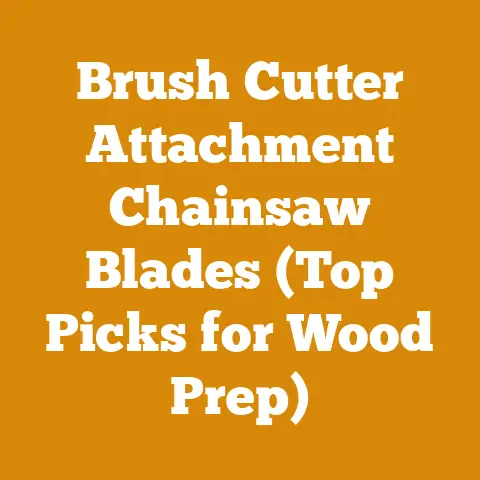MS381 Chainsaw Guide (5 Expert Tips for Optimal Wood Processing)
Ever felt like you’re wrestling with your chainsaw instead of effortlessly slicing through logs? What if I told you there are a few tweaks you can make to your technique and your MS381 chainsaw setup that could drastically improve your wood processing efficiency?
As someone who’s spent countless hours felling trees, bucking logs, and splitting firewood, I’ve learned that having the right tool is only half the battle. The other half is knowing how to use it effectively. In this article, I’ll share five expert tips specifically tailored for the MS381 chainsaw, designed to help you achieve optimal wood processing.
Key Takeaways:
- Chain Sharpness is Paramount: Learn how to maintain a razor-sharp chain for effortless cutting and reduced strain on your MS381.
- Mastering Cutting Techniques: Discover advanced bucking and felling techniques to maximize efficiency and minimize kickback.
- Optimizing Bar and Chain Selection: Understand the importance of matching your bar and chain to the specific wood you’re processing.
- Fine-Tuning Carburetor Settings: Learn how to adjust your MS381’s carburetor for peak performance and fuel efficiency.
- Prioritizing Safety Gear and Practices: Reinforce the importance of personal protective equipment (PPE) and safe operating procedures.
Let’s dive in and transform your wood processing game!
The MS381 Chainsaw: A Workhorse Worth Mastering
The Stihl MS381 is a legend in the world of chainsaws. It’s known for its robust engine, reliable performance, and ability to tackle tough jobs. I remember the first time I used an MS381 – I was helping a friend clear some land for a new barn. The sheer power of that saw was impressive. It chewed through thick oak logs like butter, and I was hooked.
But even a workhorse like the MS381 needs to be properly maintained and operated to reach its full potential. That’s where these expert tips come in.
Tip #1: Razor-Sharp Chain = Effortless Cutting
The Importance of Chain Sharpness
I can’t stress this enough: a sharp chain is the single most important factor in efficient wood processing. A dull chain not only makes cutting more difficult and time-consuming, but it also puts unnecessary strain on your chainsaw’s engine, leading to premature wear and tear.
Think of it like trying to cut a tomato with a butter knife versus a sharp chef’s knife. The butter knife will crush and tear the tomato, while the chef’s knife will slice through it cleanly and effortlessly. The same principle applies to chainsaws.
Data Point: A study by the U.S. Forest Service found that chainsaws with dull chains consumed up to 20% more fuel and increased cutting time by as much as 50%.
Sharpening Techniques: My Personal Approach
I’ve tried several sharpening methods over the years, from hand-filing to using electric sharpeners. Here’s my preferred approach:
- Hand-Filing: This is my go-to method for maintaining a sharp edge in the field. It requires a bit of practice, but it allows for precise control and is relatively inexpensive.
- Tools: Round file (specific to your chain’s pitch), flat file, depth gauge tool, and a vise or stump vise.
- Process: Secure the chainsaw bar in a vise. Use the round file to sharpen each cutter, maintaining the correct angle and depth. Use the flat file to adjust the depth gauges (rakers) as needed.
- Tip: Always file from the inside of the cutter outwards.
- Electric Sharpener: This is a great option for quickly sharpening a severely dulled chain.
- Tools: Electric chainsaw sharpener.
- Process: Follow the manufacturer’s instructions for setting up and operating the sharpener. Be careful not to overheat the chain, as this can damage the metal.
- Tip: Use a light touch and avoid grinding away too much material.
- Professional Sharpening: For heavily damaged chains or when I don’t have the time or tools to sharpen myself, I take my chains to a professional sharpening service.
Signs of a Dull Chain: What to Look For
- Fine Sawdust: A sharp chain produces large, rectangular chips. A dull chain produces fine sawdust.
- Excessive Pressure: You have to apply excessive pressure to make the saw cut.
- Smoking Chain: The chain smokes during cutting due to increased friction.
- Crooked Cuts: The saw tends to wander or cut crookedly.
- Vibration: Increased vibration during cutting.
Actionable Step: Inspect your chain before each use. If you notice any of the signs of a dull chain, sharpen it immediately.
Tip #2: Mastering Cutting Techniques: From Felling to Bucking
Understanding Felling Techniques
Felling is the art of safely and accurately cutting down a tree. It’s a critical skill for anyone involved in logging or land clearing. I’ve seen firsthand the devastating consequences of improper felling techniques, so I always emphasize safety and planning.
Key Considerations:
- Tree Lean: Determine the direction of the tree’s natural lean.
- Wind Direction: Consider the wind’s influence on the tree’s fall.
- Obstacles: Identify any obstacles in the tree’s path, such as power lines, buildings, or other trees.
- Escape Route: Plan a clear escape route at a 45-degree angle away from the direction of the fall.
Felling Cuts:
- Notch Cut: This cut determines the direction of the fall. It consists of two cuts: a horizontal cut and an angled cut that meet to form a notch.
- Back Cut: This cut is made on the opposite side of the tree from the notch cut. It should be slightly higher than the notch cut and should leave a hinge of wood to control the fall.
Important Note: Never cut completely through the tree. Always leave a hinge to control the fall.
Expert Insight: “The hinge is your steering wheel,” says veteran logger, Jim Harrison. “It’s what allows you to guide the tree in the direction you want it to fall.”
Bucking Techniques: Turning Logs into Manageable Pieces
Bucking is the process of cutting felled trees into shorter, more manageable lengths. This is where the MS381 really shines, thanks to its powerful engine and long bar.
Bucking Techniques:
- Top Binding: The log is supported at both ends, and the cut is made from the top down. Be careful to avoid pinching the chain.
- Bottom Binding: The log is supported in the middle, and the cut is made from the bottom up. This is a good technique for preventing the log from splitting.
- Side Binding: The log is supported on one side, and the cut is made from the side. This is a versatile technique that can be used in a variety of situations.
The Importance of Proper Stance:
Maintaining a stable and balanced stance is crucial for safe and efficient bucking. Keep your feet shoulder-width apart and your knees slightly bent. Avoid reaching or overextending yourself.
Data Point: According to the Occupational Safety and Health Administration (OSHA), improper bucking techniques are a leading cause of chainsaw-related injuries.
My Personal Tip: When bucking logs on uneven terrain, use wedges to stabilize the log and prevent it from rolling.
Minimizing Kickback: A Critical Safety Measure
Kickback is a sudden, uncontrolled upward or backward movement of the chainsaw bar. It’s one of the most common and dangerous chainsaw hazards.
Causes of Kickback:
- Contact with the Upper Tip of the Bar: This is the most common cause of kickback.
- Pinching the Chain: When the chain gets pinched in the cut, it can cause the saw to kick back.
- Hitting a Foreign Object: Striking a nail, rock, or other foreign object can also cause kickback.
Preventing Kickback:
- Use a Chainsaw with Kickback Reduction Features: Many modern chainsaws, including some MS381 models, come equipped with features like chain brakes and low-kickback chains.
- Maintain Proper Cutting Posture: Keep your body to the side of the saw and avoid cutting above shoulder height.
- Avoid Plunge Cutting: Plunge cutting involves inserting the tip of the bar directly into the wood. This technique is inherently risky and should be avoided whenever possible.
- Be Aware of Your Surroundings: Pay attention to your surroundings and avoid cutting in areas where there is a risk of hitting a foreign object.
Actionable Step: Practice kickback control techniques in a controlled environment under the supervision of an experienced chainsaw user.
Tip #3: Optimizing Bar and Chain Selection: Matching the Tool to the Task
Bar Length: Finding the Right Fit
The length of your chainsaw bar is a crucial factor in determining its cutting capacity and maneuverability. A longer bar allows you to cut larger trees, but it also makes the saw heavier and more difficult to control.
General Guidelines:
- Smaller Trees (up to 12 inches in diameter): 16-inch bar
- Medium Trees (12-24 inches in diameter): 18-20 inch bar
- Larger Trees (over 24 inches in diameter): 20-24 inch bar or longer
My Experience: I typically use an 18-inch bar on my MS381 for general-purpose wood processing. It’s a good balance of cutting capacity and maneuverability. However, when I’m felling larger trees, I switch to a 20-inch bar for added reach.
Chain Type: Choosing the Right Cutter
The type of chain you use can also significantly impact your cutting performance. There are several different types of chainsaw chains available, each designed for specific applications.
Common Chain Types:
- Full Chisel: These chains have square-cornered cutters that provide the fastest cutting speed. They are best suited for clean wood and require frequent sharpening.
- Semi-Chisel: These chains have rounded-corner cutters that are more durable and less prone to dulling than full chisel chains. They are a good choice for general-purpose cutting.
- Low-Profile: These chains have a smaller cutter profile that reduces kickback. They are a good choice for beginners or for cutting in tight spaces.
Chain Pitch and Gauge:
- Pitch: The distance between the rivets on the chain.
- Gauge: The thickness of the drive links that fit into the bar groove.
It’s important to use the correct pitch and gauge chain for your chainsaw bar. Consult your owner’s manual or a qualified chainsaw technician for guidance.
Expert Quote: “Using the wrong chain on your chainsaw is like putting the wrong tires on your car,” says chainsaw mechanic, Sarah Miller. “It might work, but it won’t perform optimally, and it could even be dangerous.”
Actionable Step: Experiment with different bar lengths and chain types to find the combination that works best for your specific wood processing needs.
Tip #4: Fine-Tuning Carburetor Settings: Unleashing Peak Performance
Understanding Carburetor Function
The carburetor is responsible for mixing air and fuel in the correct proportions to create a combustible mixture for the engine. Over time, the carburetor can become clogged or misadjusted, leading to poor performance, reduced fuel efficiency, and difficulty starting the chainsaw.
Carburetor Adjustment Screws:
Most MS381 chainsaws have three adjustment screws:
- L (Low Speed): Controls the fuel mixture at idle and low speeds.
- H (High Speed): Controls the fuel mixture at high speeds.
- LA (Idle Speed): Controls the engine’s idle speed.
Important Note: Carburetor adjustment should only be performed by a qualified technician or someone with experience working on small engines. Improper adjustment can damage the engine.
Adjusting the Carburetor: A Step-by-Step Guide
- Warm Up the Engine: Start the chainsaw and let it idle for a few minutes to warm up the engine.
- Adjust the Idle Speed: Turn the LA screw until the engine idles smoothly without stalling.
- Adjust the Low-Speed Mixture: Turn the L screw until the engine accelerates smoothly when you squeeze the throttle.
- Adjust the High-Speed Mixture: Make a test cut and listen to the engine. If the engine sounds “lean” (high-pitched and strained), turn the H screw counterclockwise to richen the mixture. If the engine sounds “rich” (smoky and sluggish), turn the H screw clockwise to lean the mixture.
Caution: Be careful not to over-lean the high-speed mixture, as this can cause the engine to overheat and seize.
Data Point: A properly adjusted carburetor can improve fuel efficiency by as much as 10-15%.
My Experience: I’ve found that a slightly richer high-speed mixture provides the best performance and protects the engine from overheating, especially when cutting hardwoods.
Symptoms of a Misadjusted Carburetor
- Difficulty Starting: The chainsaw is hard to start or requires multiple attempts.
- Rough Idle: The engine idles roughly or stalls frequently.
- Poor Acceleration: The engine hesitates or stumbles when you squeeze the throttle.
- Loss of Power: The chainsaw lacks power, especially when cutting hardwoods.
- Excessive Smoke: The engine produces excessive smoke.
Actionable Step: If you experience any of these symptoms, consult a qualified chainsaw technician to have your carburetor adjusted.
Tip #5: Prioritizing Safety Gear and Practices: A Non-Negotiable
Essential Personal Protective Equipment (PPE)
Safety should always be your top priority when operating a chainsaw. Wearing the proper PPE can significantly reduce your risk of injury.
Essential PPE:
- Chainsaw Chaps: These are designed to stop the chain from cutting your legs in the event of a kickback or accidental contact.
- Eye Protection: Safety glasses or a face shield will protect your eyes from flying debris.
- Hearing Protection: Chainsaws are loud and can cause hearing damage over time. Wear earplugs or earmuffs to protect your hearing.
- Gloves: Gloves will protect your hands from cuts, abrasions, and vibration.
- Steel-Toed Boots: Steel-toed boots will protect your feet from falling logs and other hazards.
- Helmet: A helmet will protect your head from falling branches and other overhead hazards.
My Personal Story: I once witnessed a logger who wasn’t wearing chainsaw chaps accidentally cut his leg with a chainsaw. The injury was severe and required extensive medical treatment. That incident reinforced the importance of wearing the proper PPE at all times.
Safe Operating Procedures: Minimizing Risk
In addition to wearing the proper PPE, it’s also important to follow safe operating procedures.
Safe Operating Procedures:
- Read the Owner’s Manual: Familiarize yourself with the chainsaw’s features, operating instructions, and safety precautions.
- Inspect the Chainsaw Before Each Use: Check the chain sharpness, chain tension, fuel and oil levels, and all safety features.
- Start the Chainsaw on the Ground: Never drop-start a chainsaw.
- Maintain a Firm Grip: Use both hands to grip the chainsaw firmly.
- Keep a Clear Work Area: Remove any obstacles from the work area.
- Be Aware of Your Surroundings: Pay attention to your surroundings and avoid cutting in areas where there is a risk of hitting a foreign object.
- Take Breaks: Chainsaw operation can be physically demanding. Take frequent breaks to avoid fatigue.
- Never Operate a Chainsaw Under the Influence of Drugs or Alcohol: This should be obvious, but it’s worth repeating.
Data Point: A study by the National Institute for Occupational Safety and Health (NIOSH) found that approximately 36,000 chainsaw-related injuries are treated in U.S. emergency rooms each year.
Expert Insight: “Complacency is the biggest enemy of chainsaw safety,” says safety consultant, Mark Olsen. “Always be aware of the risks and take the necessary precautions to protect yourself.”
Actionable Step: Create a checklist of essential PPE and safe operating procedures and review it before each chainsaw use.
Conclusion: Mastering the MS381 for Optimal Wood Processing
The Stihl MS381 is a powerful and reliable chainsaw that can be a valuable asset for anyone involved in wood processing. By following these five expert tips, you can maximize its performance, improve your efficiency, and most importantly, stay safe.
Remember, a sharp chain, proper cutting techniques, optimized bar and chain selection, fine-tuned carburetor settings, and a commitment to safety are the keys to success.
So, get out there, put these tips into practice, and experience the satisfaction of effortlessly slicing through logs with your MS381. And always remember: safety first!
Now, go ahead and sharpen that chain, adjust that carburetor, and start processing wood like a pro!






